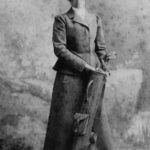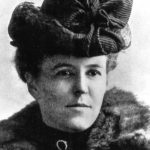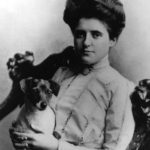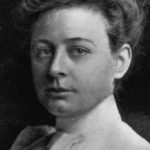
The Founders of the Women’s MGA (2024)
About The Founders of the Women’s MGA (2024)
Long before the likes of Lexi Thompson, Nelly Korda, and Rose Zhang came Ruth Underhill and Beatrix Hoyt.
Between them, Hoyt and Underhill, young women golfers from prominent New York families, won four of the first five U.S. Women’s Amateur Championships. The tournament was begun 1895, and in the absence of a professional circuit for (women or men) at the time, it served as the national championship. (The U.S. Women’s Open didn’t debut until 1946.)
With their fashionably long skirts and plumed and beribboned wide-brimmed hats, the pioneers of women’s golf in America did more than simply excel on the course, however. They employed vision and determination in a male-dominated world to lay a foundation upon which generations of female golfers would thrive.
Together, Hoyt, who was a member of Shinnecock Hills; Underhill, of Nassau Country Club; and three of their peers – Emma Leavitt-Morgan (Baltusrol), Mrs. William Shippen (Morris County Golf Club), and Mrs. DeWitt Cochrane (Ardsley Country Club) – founded the Women’s Metropolitan Golf Association in 1899.
As their model, the founders looked to the Women’s Golf Association of Philadelphia, which had formed in 1897, the same year the MGA was established. They also drew on the success of a group of similarly trailblazing women, including Shippen and Leavitt-Morgan, who founded Morris County Golf Club in New Jersey in 1894.
In October of 1899, the WMGA founders sent a letter of inquiry to established clubs in the Met Area, expressing a statement of purpose: “the promotion of the interests of golf, and more particularly the encouragement of team play and the holding of an annual championship.” Twenty-three clubs signed on, agreeing to pay annual dues of $10.
The WMGA’s first formal meeting took place on April 27, 1900, in New York City. Those present elected a slate of officers, adopted a constitution and by-laws, and presented a schedule of events – highlighted by an inaugural championship to be held 45 days hence.
Fittingly, the tournament was played at Morris County Golf Club. The competition commenced with 18 holes of medal play, followed by four rounds of match play. The top 16 qualifiers vied for the championship, the next 16 for a consolation cup. To the surprise of many, Hoyt, the favorite, lost in the semifinals to a Genevieve Hecker, a 17-year-old from Wee Burn Country Club in New Canaan, Conn., who went on to defeat Underhill in the final.
Reporting on the championship, the USGA proclaimed that “Miss Hecker’s driving had the power and snap about it that have always distinguished” the tee shots of Hoyt. “Both play with a rather short swing, but there is a steely springiness in the way the club head comes down upon the ball and the result is good distance and power to negotiate heavy lies.”
For years, the WMGA operated on a shoestring budget. Having no formal headquarters, the founders would meet in one another’s Manhattan homes; for correspondence, they used the mailing address of Underhill’s townhouse (6 East Ninth Street). Eventually, in 1928, the association opened its first office, occupying a room in a school in Lower Manhattan run by the father of one of its members.
In the decades that followed, the WMGA moved several more times. From World War II until the mid-1960s, it rented space in the New York headquarters of the USGA. When the USGA no longer had room to spare, the WMGA leased various quarters of its own in Manhattan until, in the face of rising rents, it moved in 1994 to Golf Central, home of the MGA, in Elmsford, N.Y.
With the exception of a year’s hiatus during World War I and a three-year pause during World War II, the WMGA has held its Match Play Championship continuously since Hecker won the inaugural in 1900.
The list of winners features some of the leading figures in the early history of women’s golf in America. They include Marion Hollins, who followed a successful playing career by overseeing the development of Cypress Point Club on California’s Monterey Peninsula and consulting on the design of Augusta National; Alexa Stirling, a three-time national champion and lifelong friend of Bobby Jones; and Helen Hicks, a Long Island native who won national championships in the U.S. and Canada, became a founding member of the LPGA, and, thanks to her lucrative endorsement of Wilson Sporting Goods, was the first woman to earn a living playing golf.
Still another legend whose name graces the silver trophies of the WMGA – and has become synonymous with the association – is Maureen Orcutt. The daughter of a Scottish newspaperman and avid golfer, Orcutt followed in her father’s footsteps on both accounts.
In addition to becoming a longtime golf writer for The New York Times, she had an extraordinary amateur golf career that included being named to the United States Curtis Cup team four times. Orcutt’s first victory of note came in the WMGA Junior Girls’ Championship in 1922. She would go on to win 27 more WMGA titles, including 10 match-play championships over a span of 42 years, from 1926 to 1968. In 1998, the association named her the WMGA Golfer of the Century. In addition, Orcutt, who died in 2007 at the age of 99, is a member of the MGA Hall of Merit (as are Hicks and Hollins).
Adding to her legacy, since 1960, White Beeches Country Club in Haworth, N.J., where she learned to play, has hosted the Maureen Orcutt Trophy Tournament, an annual 18-hole stroke-play competition for girls.
A commitment to providing opportunities for junior girls has long been central to the WMGA. Many accomplished players have come of age competing in its individual and team events.
An especially talented cohort emerged in the late 1980s and ’90s. Karen Noble won three consecutive Match Play titles from 1988 to 1990 and later joined the LPGA Tour. She now serves as director of instruction at Fairmount Country Club in Chatham, N.J. Diana D’Alessio captured the Match Play in 1995 and 1996 and went on to play the LPGA Tour and what is now the Ladies European Tour.
Debbie Doniger followed a similar path. After winning the WMGA Junior Girls’ Championship in 1986 and 1987 and the Match Play in 1992, she, too, played professionally, first on minitours in Florida then on the European Tour. Now the director of instruction at GlenArbor Golf Club in Bedford Hills, N.Y., and ranked by Golf magazine as one of the top 100 teachers in America, Doniger says she will be “forever grateful” for the opportunities she had to compete as a junior golfer in the Met Area.
“My career,” she says, “would not be as prolific if not for the WMGA – its participants, leaders, and foresight to provide for the juniors.”
As it celebrates its 125th anniversary this year, the WMGA has come a long way from the fledgling association begun by its visionary founders in 1899. It now has 193 member clubs and 2,372 individual members. Thanks to a 2017 change to the group’s constitution and by-laws, membership is open to amateur women golfers who do not belong to member clubs.
In 2001, the association created the WMGA Foundation, with the mission of providing college scholarships to young women who have an interest in golf, fostering girls’ involvement in the sport and promoting the game to all women.
WMGA officials are also working on creating an “e-museum,” or online archive, of the association’s Hall of Fame, awards and trophies, tournaments, and founding clubs. Hoyt, Underhill, Leavitt-Morgan, Shippen, and Cochrane would surely be proud. – Paul Rogers
Connection to MGA. . .
Founded the Women’s Metropolitan Golf Association in 1899, The WMGA’s first formal meeting took place on April 27, 1900, in New York City.
Founding Members
Emma Leavitt-Morgan
Mrs. William Shippen
Mrs. DeWitt Cochrane
Ruth Underhill
Beatrix Hoyt
ADDITIONAL DETAILS & MULTIMEDIA
Achievements
- 193 member clubs and 2,372 individual members.
- In 2001, The association created the WMGA Foundation
- WMGA officials are also working on creating an “e-museum,” or online archive, of the association’s Hall of Fame, awards and trophies, tournaments, and founding clubs.
- Membership is open to amateur women golfers who do not belong to member clubs.




